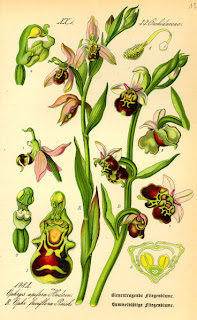
With endless diversity of orchids, it's interesting that the name "Orchid" derives from a trait seen by very few members of the genus - that is of the appearance of the tubers of a handful of European terrestrial orchids, such as Orchis mascula, also called the "early purple orchid".

The name is a 'double whammy', just in case someone doesn't get the point. "Orchis" refers to testicle. Then there's the "mascula" species name. From
'The uses and misuses of orchids in medicine",
"The Greeks referred to testicles as orchis, and Theophrastus (372–286 BC) named the orchids from that word, as the underground tubers of many European terrestial orchids resemble a pair of testicles. In his Enquiry into Plants, he reported that the orchids had medicinal properties." The article continues, "
In the first century AD, Dioscorides, who was a Greek working as a Roman military physician, wrote his De Materia Medica, including two terrestrial orchids. He adopted and promoted the ‘Doctrine of Signatures’ whereby plants were used for medicinal purposes according to their resemblance to parts of the human anatomy, for example by shape or colour. Naturally this led to orchid tubers being used to heal diseases of the testicles, and to stimulate lust. Moreover if given to men as whole fat new tubers this was supposed to produce male progeny, and if the shrivelled old tubers were given to women, this should produce female children. From wikipedia (as are the illustrations here), regarding the drink "
Salep" that is made from ground tubers of Orchis mascula, "
The Ancient Romans also used ground orchid bulbs to make drinks, which they called by a number of names, especially satyrion and priapiscus. As the names indicate, they likewise considered it to be a powerful aphrodisiac." also,
"Of Salep, Paracelsus the famous toxicologist wrote: "Behold the Satyrion root, is it not formed like the male privy parts? Accordingly magic discovered it and revealed that it can restore a man's virility and passion" The concept that plant parts that resemble human parts, can be used medicinally to treat those human parts, is called "
The doctrine of signatures",
"a philosophy shared by herbalists from the time of Dioscurides and Galen."It was thought that divine signatures led to information about the plants, so that humanity would be guided to use those plants for medicines.

The flower itself looks rather plain at a distance, but up close has the typical appearance for orchid flowers.
Not only was it thought that orchids could treat "testicular conditions", the speculation was that they derived from animal sexual origins. Again from "The uses and misuses of orchids in medicine", "
In the sixteenth century, Hieronymus Tragus (Jerome Bock) (1498–1554) decided that they must arise (owing to their testicular shapes) from the semen of birds and beasts when this fell to the ground. In 1665, Anthanasuis Kircher, in his Mundus Subterraneus, concluded that as bees arose from the carcasses of bulls, bee orchids must arise from the semen of bulls". Wow.

The closely related, and similar appearing,
Orchis militaris, is/was used for the same purposes.
It appears to be a close relative, and carries the same genus name. The flower color may be different, although even the "Early purple orchid" appears to come in pink and white.

Quite a lovely flower, up close. Again, even though there is variation, it's obvously an orchid flower with a colorful lip (labellum).

Interestingly, a different type of mimicry does relate to a "birds and bees" situation. The similar orchid,
Ophrys apifera, also a European terrestrial orchid, has a flower that male bees find looks so similar to female bees that they try to copulate with the flowers. They derive no nutrition from the flower, no nectar - just the bogus sexuality that the flower offers. The frustrated bee then flies to the next flower, thus transferring pollen as he again attempts copulation with a fake partner, an orchid flower pretending to be his hot date.

This trend of fakery is repeated frequently in the Orchid family, with many species around the globe luring insects into sexual encounters that benefit the plant but not the insect.

This was from wikimedia commons, labeled as "
Ophrys fuciflora". I liked the illustration so included it here.
In medicine, the same words are still used today. "cryptorchidism" refers to undescended, and therefore hidden, testicle. "Orchiectomy" refers to removal of a testicle.
So, bottom line, is that when we speak of "Orchids" we are speaking of plants that are related to plants that had tubers that ancients thought looked like testicles. That's even though very few orchid species have tubers at all, and even though the properties of the tubers had nothing to do with human virility or reproduction.







